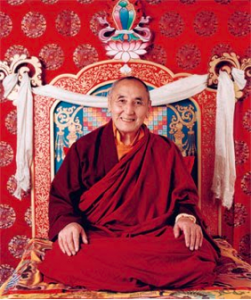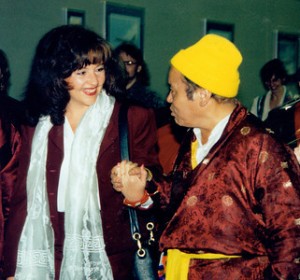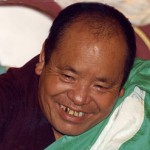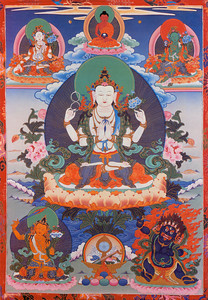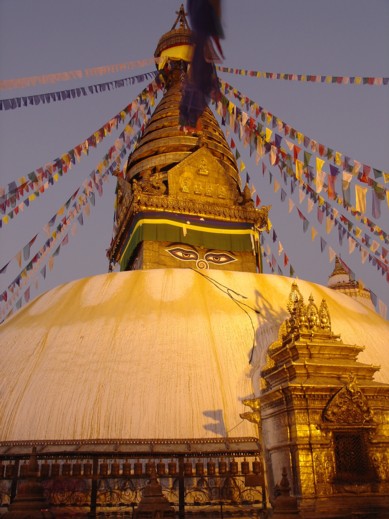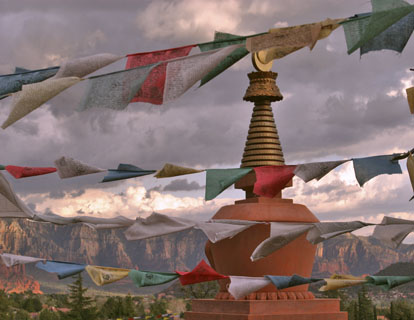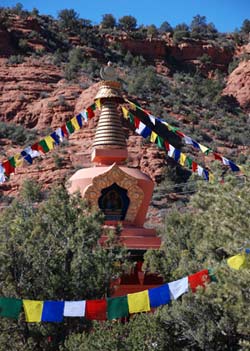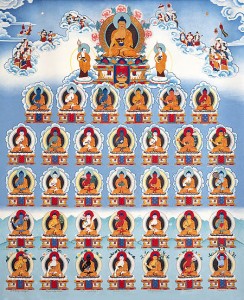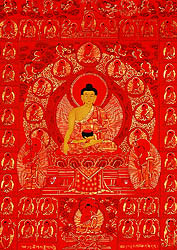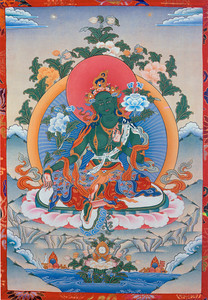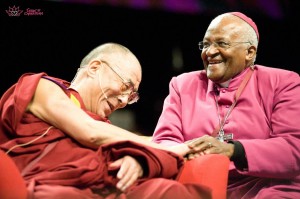H.E. Ven. Yangthang Tulku is a highly revered Lama in the Nyingmapa Lineage of Tantrayana Buddhism. He is known to be the embodiment of Vimalamitra, a Dzogchen Master regarded as the chief propagator of Buddhism in Sikkim. In his past life he was also the great terton Lhatsen Namkha Jigmed from Sikkim whose treasures are included in the Rinchen Terzod. But he is perhaps most well known as the reincarnation of Dorje Dechen Lingpa, the Tertön from Dhomang, who has successfully retrieved many Terma Buddhist scriptures which were secretly concealed by Padmasambhava. Only the truly accomplished Dharma practitioner prophesied by Padmasambhava, can reveal these sacred treasures.
At the very moment that Dhomang Terchen’s incarnation was born (1923) in Sikkim, all directions in the sky in Sikkim resounded in thunder, “I am here!” He was discovered exactly as described, born into the Yangthang family. This is why Rinpoche is known now as Yangthang Rinpoche. A second emanation was born in Sikkim and was brought up together with his older counterpart. When Yangthang Rinpoche was invited back to his monastery in Tibet, the younger emanation also insisted upon joining him. The two young boys departed with their party, playing and performing many miracles along the journey.
Upon returning to Dhomang Monastery both tulkus were put in the hands of Sogtrul Rinpoche and many other lamas at Dhomang. They were given the finest and best education with Khenpo Pema from the Palyul Mother Monastery as their personal instructor. Thus, both tulkus were able to fully complete all their studies. In addition to mastering the extensive training in practices of his lineage, Yangthang Rinpoche was completely trained in the Kangyur and Tangyur, and in the works of Longchenpa.
In Tibet, before the Cultural Revolution, Yangthang Rinpoche gave the entire Kangyur transmission and many other great empowerments. He became the head of Dhomang Monastery and carried out all the administrative duties personally.
After remaining in retreat for more than 20 years under harsh conditions, Ven. Yangthang Rinpoche moved to Pelling, West Sikkim in 1958. That same year, the Communist Chinese captured and killed Sogtrul Rinpoche and the younger tulku. In 1959, Yangthang Rinpoche fled Dhomang. He was later captured by the Chinese, and imprisoned for 22 years. While imprisoned, he helped many fellow prisoners who could not bear the hardship to die peacefully by performing P’howa, transferring their consciousness to Pure Lands. Though he witnessed and experienced much torture, he bears no resentment to his captors, only compassion. In fact, he became a spiritual advisor to some of the guards. When people express sympathy about his imprisonment, Rinpoche says that because of Dharma, his mind was freer in prison than worldly people experience in the best of circumstances.
Following the death of Mao Tse Tung he was released. He returned to Dhomang to find his monastery completely dismantled. He then obtained permission to go to Sikkim. As a simple yogi he traveled back and forth to Nepal and Bhutan, receiving transmissions and empowerments from His Holiness Dilgo Khyentse Rinpoche and His Holiness Dodrubchen Rinpoche.
In 1985, while circumambulating the Great Stupa in Bodhanath, Yangthang Rinpoche met with Gyaltrul Rinpoche, who at that time was leading a group of his American students on pilgrimage to the sacred shrines of the Dharma. These two lamas had not seen each other in 26 years. Fleeing from the invading Communist Chinese, they had initially left Dhomang together but parted company at a fork in the road. One fork led Gyaltrul Rinpoche to freedom in India, the other led Yangthang Rinpoche to imprisonment. At the request of Gyaltrul Rinpoche, Yangthang Rinpoche first came to the U.S. in 1990. He gave many profound teachings and transmissions, and was enthusiastically welcomed wherever he taught. Yangthang Rinpoche returned to the U.S. for a second tour of teaching and transmission in 1997, and for a third tour in 2002. In between his travels to the United States, Europe and Asia, Rinpoche has gone back to his root temple, Dhomang Temple in Sichuan, China to rebuild and refurbish the dismantled temple.
Among the Tertons, exceptional manifestations have been given the title ‘Lingpa’ in acknowledgment of their remarkable qualities. Like Ratna Lingpa, Karma Lingpa, Chogyur Lingpa and others, Dorje Dechen Lingpa revealed many volumes of treasures and was an undisputed realized master, a manifestation of the wisdom and compassion of all the Buddhas. Moreover, Yangthang Tulku is of course also an emanation of Vimalamitra, just as Kyabje Penor Rinpoche was. Vimalamitra’s wisdom is inseparable from Guru Rinpoche’s, the source of the blessings of all the revealed treasures. Yanthang Rinpoche is known as a compassionate, humble, no-nonsense Dzogchen master and one of the principle lineage holders of the Nyingmapa Lineage. He is widely recognized for the quality and depth of his realization, the power of his attainment, and the purity of his transmissions.
Kyabje Pema Norbu Rinpoche, the 11th throne holder of Palyul Lineage, has pronounced that “There is no difference between myself and Yangthang Rinpoche.” Gyaltrul Rinpoche has stated that “Yangthang Rinpoche is the great achiever of Dharma, an extremely precious gem in this modern age.” Venerable Yangthang Rinpoche currently resides in West Sikkim.
References: PathtoBuddha.org
Mahasiddha.org
OrgyenDorjeDen.org
